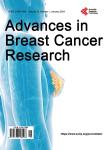The Role of Serum Trace Elements and Oxidative Stress in Egyptian Breast Cancer Patients
The Role of Serum Trace Elements and Oxidative Stress in Egyptian Breast Cancer Patients作者机构:Department of Chemical Pathology Medical Research Institute Alexandria University Alexandria Egypt Department of Cancer Management and Research Medical Research Institute Alexandria University Alexandria Egypt Department of Surgery Medical Research Institute Alexandria University Alexandria Egypt
出 版 物:《Advances in Breast Cancer Research》 (乳腺癌(英文))
年 卷 期:2016年第5卷第1期
页 面:37-47页
学科分类:1002[医学-临床医学] 100214[医学-肿瘤学] 10[医学]
主 题:Trace Elements Oxidative Capacity Breast Cancer Antioxidants
摘 要:Background: Oxidative stress is considered to be involved in the pathophysiology of all cancers. Studies indicated that the levels of oxidative stress markers increased in breast cancer. Trace metals are essential to normal human homeostasis. When present in an abnormal expression, they contribute in many pathological processes. Some trace metals are claimed to be carcinogenic and capable of inducing a toxic effect through the formation of free radicles and acting as cofactors in the oxidative damage of biological macromolecules and DNA. Objective: Our aim was to investigate the serum levels of some trace elements (Copper, Zinc and Cadmium), the total oxidative and anti-oxidative capacity (TOC and TAC) in patients with breast cancer in comparison to patients with benign breast tumours. Patients and Methods: The present study included 65 females. The participates were divided into 2 main groups: control group which consisted of 20 apparently healthy female;the patient groups which divided into 3 groups: group B included 15 patients with benign breast tumours, group N consisted of 15 newly diagnosed breast cancer patients and group M included 15 patients with metastatic breast cancer. Results: The mean serum levels of Copper, Zinc, and Cadmium were significantly higher in the three patients groups (B, N and M) than the control group. Similarly, serum uric acid (UA) and (TAC) levels showed significant higher level in both breast cancer groups as compared to the benign group. However TOC levels showed only significantly higher level in metastatic group. Conclusions: The present study suggested elevated TAC, UA and TOC in breast cancer patients. The increased levels of trace elements could lead to formation of free radicals or other reactive oxygen species. The serum profile of these trace metals may be helpful in predicting prognosis of breast cancer.



